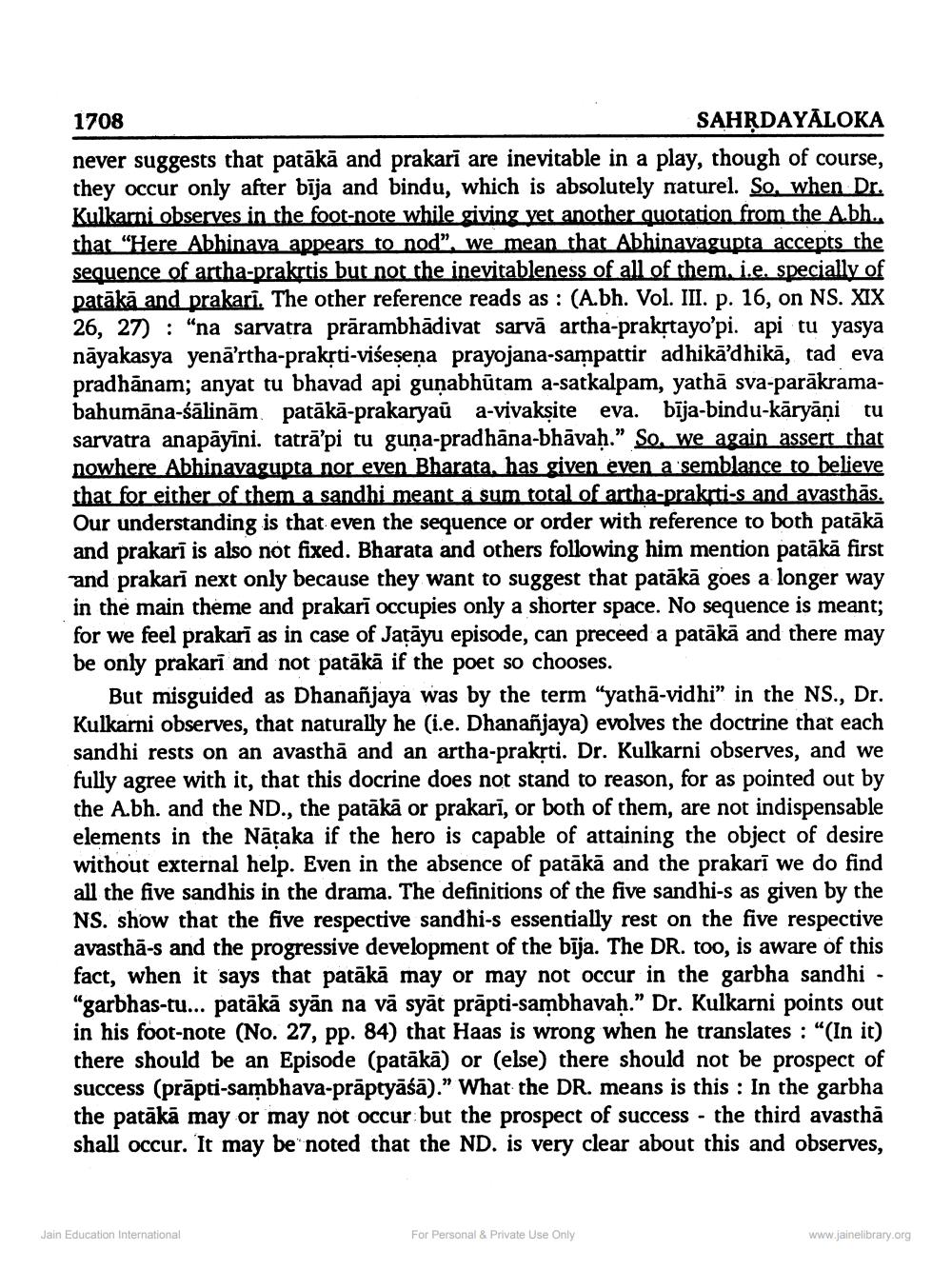________________
1708
SAHRDAYĀLOKA never suggests that patākā and prakari are inevitable in a play, though of course, they occur only after bīja and bindu, which is absolutely naturel. So, when Dr. Kulkarni observes in the foot-note while giving yet another quotation from the Abh.. that "Here Abhinava appears to nod”, we mean that Abhinavagupta accepts the sequence of artha-prakrtis but not the inevitableness of all of them. i.e. specially of patākā and prakari. The other reference reads as : (A.bh. Vol. III. p. 16, on NS. XIX 26, 27) : "na sarvatra prārambhādivat sarvā artha-prakstayo'pi. api tu yasya nāyakasya yenā'rtha-praksti-viśeşena prayojana-sampattir adhikā'dhikā, tad eva pradhānam; anyat tu bhavad api gunabhūtam a-satkalpam, yathā sva-parākramabahumāna-śālinām patākā-prakaryaū a-vivaksite eva. bīja-bindu-kāryāni tu sarvatra anapāyīni. tatrā'pi tu guna-pradhana-bhāvah.” So, we again assert that nowhere Abhinavagunta nor even Bharata, has given even a semblance to believe that for either of them a sandhi meant a sum total of artha-prakrti-s and avasthās. Our understanding is that even the sequence or order with reference to both patākā and prakarī is also not fixed. Bharata and others following him mention patākā first and prakarī next only because they want to suggest that patākā goes a longer way in the main theme and prakarī occupies only a shorter space. No sequence is meant; for we feel prakarī as in case of Jatāyu episode, can preceed a patākā and there may be only prakari and not parākā if the poet so chooses.
But misguided as Dhananjaya was by the term “yathā-vidhi” in the NS., Dr. Kulkarni observes, that naturally he (i.e. Dhananjaya) evolves the doctrine that each sandhi rests on an avasthā and an artha-praksti. Dr. Kulkarni observes, and we fully agree with it, that this docrine does not stand to reason, for as pointed out by the Abh. and the ND., the patākā or prakarī, or both of them, are not indispensable elements in the Nātaka if the hero is capable of attaining the object of desire without external help. Even in the absence of patākā and the prakarī we do find all the five sandhis in the drama. The definitions of the five sandhi-s as given by the NS. show that the five respective sandhi-s essentially rest on the five respective avasthā-s and the progressive development of the bīja. The DR. too, is aware of this fact, when it says that patākā may or may not occur in the garbha sandhi - "garbhas-tu... patākā syān na vā syāt prāpti-sambhavah.” Dr. Kulkarni points out in his foot-note (No. 27, pp. 84) that Haas is wrong when he translates : "(In it) there should be an Episode (patākā) or (else) there should not be prospect of success (prāpti-sambhava-prāptyāśā).” What the DR. means is this : In the garbha the patākā may or may not occur but the prospect of success - the third avastha shall occur. It may be noted that the ND. is very clear about this and observes,
Jain Education International
For Personal & Private Use Only
www.jainelibrary.org




